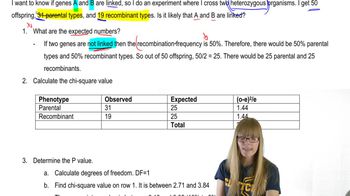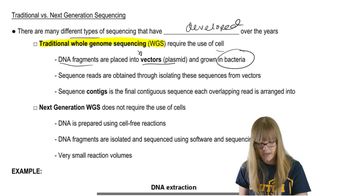Table of contents
- 1. Introduction to Genetics51m
- 2. Mendel's Laws of Inheritance3h 37m
- 3. Extensions to Mendelian Inheritance2h 41m
- 4. Genetic Mapping and Linkage2h 28m
- 5. Genetics of Bacteria and Viruses1h 21m
- 6. Chromosomal Variation1h 48m
- 7. DNA and Chromosome Structure56m
- 8. DNA Replication1h 10m
- 9. Mitosis and Meiosis1h 34m
- 10. Transcription1h 0m
- 11. Translation58m
- 12. Gene Regulation in Prokaryotes1h 19m
- 13. Gene Regulation in Eukaryotes44m
- 14. Genetic Control of Development44m
- 15. Genomes and Genomics1h 50m
- 16. Transposable Elements47m
- 17. Mutation, Repair, and Recombination1h 6m
- 18. Molecular Genetic Tools19m
- 19. Cancer Genetics29m
- 20. Quantitative Genetics1h 26m
- 21. Population Genetics50m
- 22. Evolutionary Genetics29m
4. Genetic Mapping and Linkage
Chi Square and Linkage
Problem 22
Textbook Question
T. H. Morgan's data on eye color and wing form, shown in Figures 5.3 and 5.5, reveal genetic linkage between the two genes. Test this genetic linkage data with chi-square analysis, and show that the results are significantly different from the expectation under the assumption of independent assortment.

 Verified step by step guidance
Verified step by step guidance1
Identify the observed (O) and expected (E) values for each phenotype from the table.
Calculate the chi-square value for each phenotype using the formula: \( \chi^2 = \sum \frac{(O - E)^2}{E} \).
Sum the chi-square values for all phenotypes to get the total chi-square value.
Determine the degrees of freedom, which is the number of phenotypic categories minus 1.
Compare the total chi-square value to the critical value from the chi-square distribution table at the desired significance level to determine if the results are significantly different from the expectation under independent assortment.
Recommended similar problem, with video answer:
 Verified Solution
Verified SolutionThis video solution was recommended by our tutors as helpful for the problem above
Video duration:
2mPlay a video:
Was this helpful?
Key Concepts
Here are the essential concepts you must grasp in order to answer the question correctly.
Genetic Linkage
Genetic linkage refers to the tendency of genes located close to each other on a chromosome to be inherited together during meiosis. This phenomenon contrasts with independent assortment, where genes segregate independently. T.H. Morgan's experiments demonstrated that certain traits, such as eye color and wing form in fruit flies, are linked, indicating that they are located on the same chromosome.
Recommended video:
Guided course

Chi Square and Linkage
Chi-Square Analysis
Chi-square analysis is a statistical method used to determine if there is a significant difference between observed and expected frequencies in categorical data. In genetics, it helps assess whether the inheritance patterns of traits deviate from what would be expected under the assumption of independent assortment. A significant chi-square result suggests that the traits may be linked rather than assorting independently.
Recommended video:
Guided course

Chi Square Analysis
Observed vs. Expected Counts
In the context of genetic experiments, observed counts (O) are the actual data collected from experiments, while expected counts (E) are the theoretical values predicted based on a specific hypothesis, such as independent assortment. Comparing these counts using chi-square analysis allows researchers to evaluate the validity of their assumptions about genetic inheritance and linkage.
Recommended video:
Guided course

Traditional vs. Next-Gen

 7:33m
7:33mWatch next
Master Chi Square and Linkage with a bite sized video explanation from Kylia Goodner
Start learningRelated Videos
Related Practice

